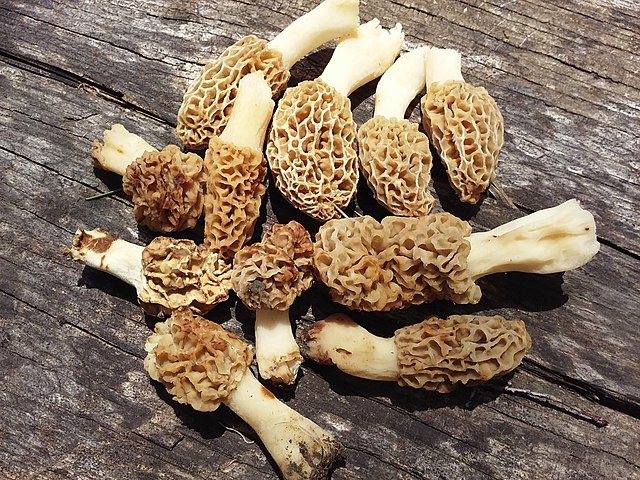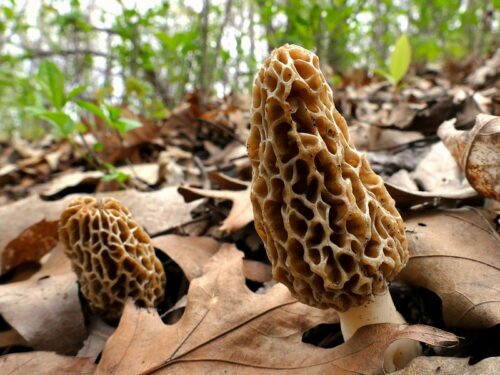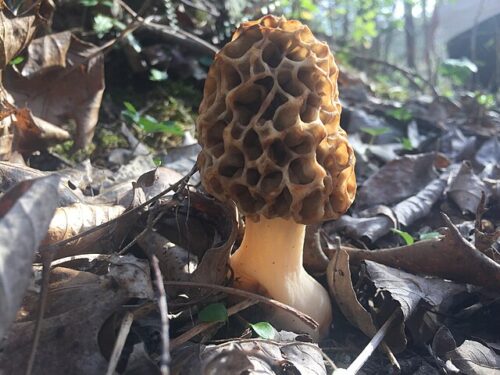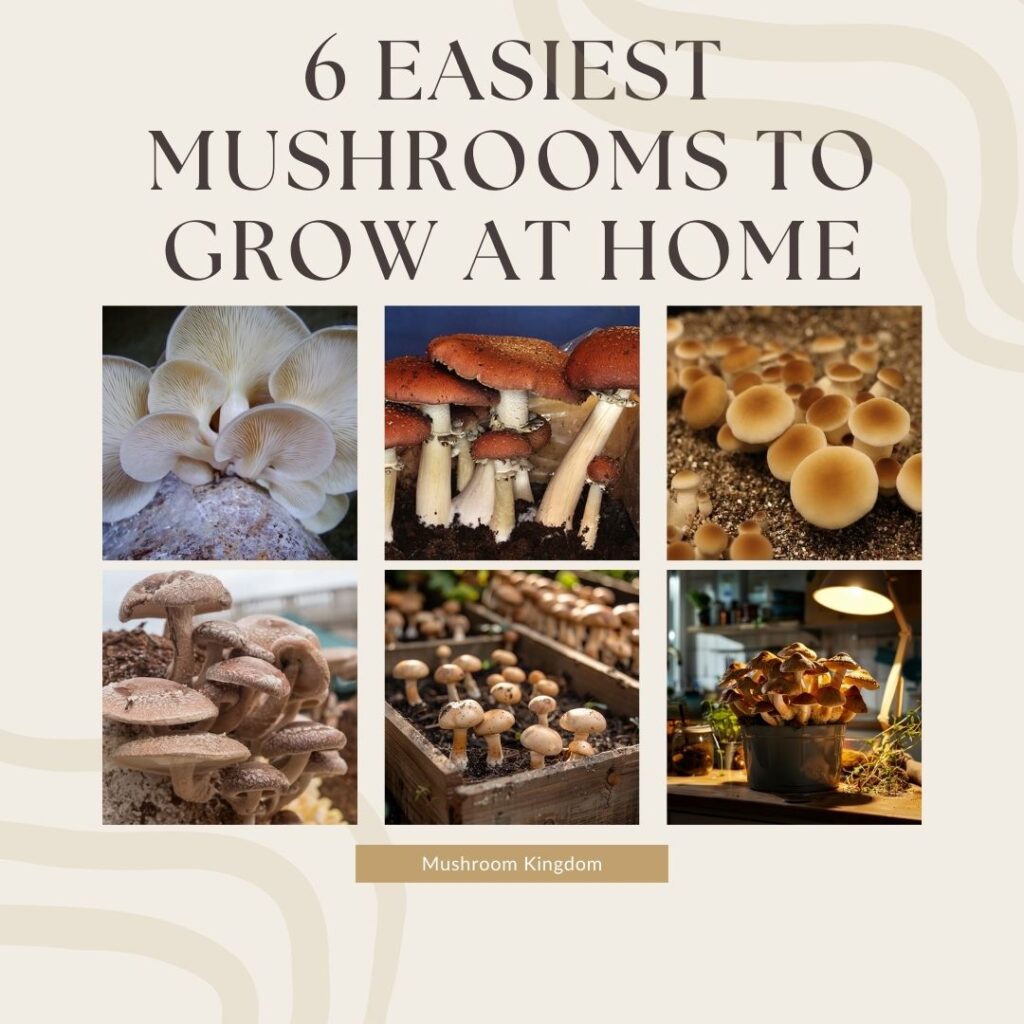Morel mushrooms, scientifically classified in the Morchella genus, are a type of edible wild mushroom known for their distinctive caps. It is one of the most popular mushrooms among foragers and is also considered a culinary delicacy.

How To Find Morel (Morchella) Mushrooms
To identify morel mushrooms, look for their distinctive honeycomb or sponge-like caps with pits and ridges, and ensure the stem is completely hollow from base to cap. Here’s an expanded guide:
Cap Shape and Texture
Morel mushrooms boast a distinctive honeycomb or sponge-like appearance on their caps. The cap is covered in pits and ridges that resemble a network of tiny cavities.

The cap typically has a conical or oval shape, tapering to a somewhat pointed or rounded top. This unique structure sets morels apart from other mushrooms.
Color
Morels display a range of colors, from tan to dark brown or even black. The specific hue often depends on the species and the age of the mushroom.

The color usually remains uniform across the entire cap, although the ridges may appear slightly darker than the pits.
Stem Characteristics
- Hollow Stem: One of the most distinctive features of a morel mushroom is its hollow stem, which runs from the base all the way to the cap.
- White to Cream Color: The stem is generally white to pale cream, contrasting with the darker cap.
- Thick and Sturdy: Morel stems are thick and sturdy, providing strong support for the cap. This characteristic helps distinguish morels from other mushrooms with flimsier stems.
Size
Varies: Morels vary in size, ranging from about 2 inches to over 12 inches tall. The size can depend on the species, growing conditions, and age of the mushroom.
False Morels and How To Avoid Them
The three common false mores are: Gyromitra, Verpa, and Helvella. These resemble true morels but can be toxic and dangerous if consumed. They typically have wrinkled, lobed, or wavy caps that lack the distinctive honeycomb pattern of true morels.
Also, fake ones may have solid or chambered stems rather than the completely hollow stems of true morels. To avoid them, focus on key identification features.
First, always check for the honeycomb cap structure; true morels have a uniform pattern of pits and ridges. Fake ones have wrinkled, lobed, or wavy caps and may not be completely hollow inside.
Next, slice the mushroom lengthwise to verify that the stem is entirely hollow. False morels often have a cotton-like substance or a series of chambers inside the stem.
Where and When Morels Grow?
Morels typically emerge in the spring. They often appear around the time of the first warm rains after winter, signalling the arrival of mushroom hunting season. These mushrooms thrive in temperatures between 60–70°F (15–21°C) during the day, with slightly cooler temperatures at night.
They prefer wooded areas, particularly around certain types of trees such as elms, ashes, oaks, and poplars. The presence of these trees often indicates a potential morel habitat.
You might also find morels in areas that have experienced forest fires, usually a year or two after the fire. These burn sites provide an ideal environment for morel growth.
Look for in moist, well-drained soil. They often grow near streams or rivers, where the ground remains damp and conducive to mushroom growth.
How To Cook Morel Mushrooms?
Always cook morels thoroughly before eating them. Eating them raw can cause stomach upset or other adverse reactions. The popular cooking methods include sautéing, frying, baking, or adding them to soups and sauces.
First, clean morels carefully to remove dirt and insects. Rinse them gently under cold water and pat them dry. Some people prefer to soak them briefly in salted water to draw out any hidden insects.
After rinsing, pat the morels dry with a paper towel. Make sure they are as dry as possible before cooking to prevent them from becoming soggy.
Sautéing
Heat a generous amount of butter or oil in a skillet over medium heat. Butter complements the rich flavor of morels well. Add the morels to the skillet and sauté them for about 5–7 minutes, stirring occasionally. Cook until they are golden brown and tender.
Season with salt, pepper, and herbs such as thyme or parsley to enhance the flavor.
Frying
Prepare a simple batter by mixing flour, salt, and pepper. You can also add some garlic powder or paprika for extra flavor. Dip the morels in the batter, ensuring they are well-coated.
Heat oil in a frying pan over medium-high heat. Once the oil is hot, add the battered morels. Fry the morels until they are crispy and golden brown, turning them occasionally. This usually takes about 3–5 minutes.
Baking
Preheat your oven to 375°F (190°C). Arrange cleaned and cut morels on a baking sheet lined with parchment paper. Drizzle them with olive oil and season with salt, pepper, and any desired herbs.
Bake for about 15–20 minutes, or until the morels are tender and slightly crispy on the edges.
Are Morel Mushrooms Good For You?
Yes, morel mushrooms can be good for you when consumed as part of a balanced diet. They are a good source of essential nutrients such as vitamins B and D, copper, manganese, and zinc. These nutrients play vital roles in maintaining overall health and well-being.
They are also low in calories which makes them a popular option for those watching their weight or looking to maintain a balanced diet.
The next key benefit is related to antioxidants. This mushroom contains antioxidants such as phenolic compounds and flavonoids, which help protect cells from damage caused by free radicals.
Lastly, the dietary fiber found in these mushrooms can promote digestive health by aiding in digestion and supporting regular bowel movements.


